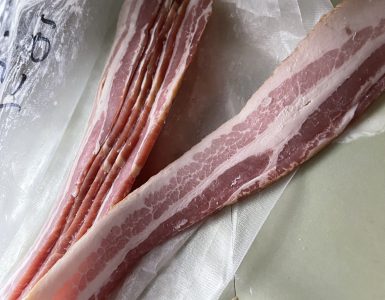Botulism Fear Mongering
Most so-called “meat smoking” gurus and their followers in various online forums rail against smoking jerky without curing salt, raising alarms about botulism poisoning. They parrot the same tired talking points about danger zones and safety, often without understanding the facts. Some even claim that smokers create an oxygen-deficient environment that encourages the growth of Clostridium botulinum. In fact, some forums outright prohibit discussing jerky without curing salt, treating it as if such advice is a menace to society’s safety. The truth? These people are well-meaning, but grossly uninformed.
Debunking the Myths
The reality is that the risk of botulism from uncured jerky is almost nonexistent. Here’s why:
- Fresh Meat is Low-Risk
Clostridium botulinum is most commonly found in soil, water, and certain foods like fish, vegetables, and honey . Fresh, well-handled meat, particularly beef, has an extremely low likelihood of carrying dormant spores. According to the CDC, botulism outbreaks in meat are exceedingly rare, and the majority of botulism cases arise from home-canned, low-acid foods . Properly handled meat is simply not a typical carrier for botulism bacteria, making the risk minimal when starting with fresh, clean meat. - Marinade Helps Prevent Growth
Botulism bacteria thrive in low-acid, anaerobic environments. Most jerky marinades, however, are packed with salt and acidic ingredients like vinegar or citrus juice, which make it nearly impossible for C. botulinum to grow. The USDA highlights that pH levels below 4.6 effectively prevent the growth of Clostridium botulinum, and many jerky marinades easily fall within this range due to their acidic components . - Refrigeration is a Safe Zone
Clostridium botulinum requires temperatures between 40°F and 120°F (4°C and 49°C) to grow . Since refrigeration keeps the temperature well below this range, any spores present would remain dormant, unable to hatch or multiply. The FDA advises storing marinating meat in the refrigerator at 40°F or below to minimize bacterial risks . - Smokers Are Not Oxygen Free
Contrary to popular belief, even in a smoker, there is still (plenty of) oxygen present. Clostridium botulinum thrives in anaerobic (oxygen-free) environments , such as vacuum-sealed packages or improperly canned foods. Smoking jerky, especially with airflow, does not create the anaerobic conditions necessary for botulism bacteria to grow. The idea that heavy smoke creates an anaerobic environment is a misunderstanding—there’s still plenty of oxygen in the smoker to keep botulism in check. - Time in the Danger Zone is Insufficient
Even in the highly unlikely event that Clostridium botulinum spores were present on the meat, they require much more time than a typical smoking process allows to become dangerous. According to the CDC, C. botulinum takes several days under warm, anaerobic conditions to produce toxins. Smoking jerky for 8-12 hours or less, even at lower temperatures around 140°F, is far too short a window for botulism to pose any real threat. During this time, the meat is drying, which also helps prevent bacterial growth. The same applies to using a dehydrator.
Why Not Use Curing Salt?
Nitrate-based curing salts undeniably change the flavor and texture of meat. While some people enjoy these changes, I personally find the flavor and texture less appealing. What’s more frustrating is the constant drumbeat of misinformation that insists uncured jerky is unsafe. The reality is that properly handled, uncured jerky can be made safely without these additives.
I am not against curing salt, it most certainly has a place as explained below.
When You Should Use Cure
While whole muscle jerky can be safely made without curing salt if proper food safety guidelines are followed, there are certain situations where curing salt is not optional.
Curing salt must be used for ground meat products like ground jerky or sausages. Unlike whole muscle cuts, ground meat has a greater risk of bacterial contamination because the grinding process distributes any surface bacteria throughout the meat. This creates a higher risk environment, making it crucial to use nitrate-based cures (like sodium nitrite) to prevent the growth of Clostridium botulinum and other harmful bacteria.
In short, any time meat is ground or processed in a way that increases the surface area exposed to air and bacteria, curing salt becomes a necessary step for ensuring safety.
See my equilibrium curing calculator for amazing jerky and bacon, and my DIY applewood smoked bacon recipe for more information.
Conclusion
While muscle jerky can be safely made without curing salt as long as basic food safety practices are followed. The combination of fresh meat, a salty, acidic marinade, refrigeration, and proper smoking techniques makes the risk of botulism incredibly low—much lower (virtually non-existent) than the internet forums might lead you to believe.
Next time an otherwise reasonable person refuses to relent on the topic of jerky cure, send them here and help to pull back some of the misinformation.
Disclaimer
While the information presented here is based on USDA guidelines and scientific evidence, it is important to follow all recommended food safety practices when making jerky. The USDA guidelines do not require the use of curing salt as long as proper food safety measures are followed, including safe handling of fresh meat, maintaining appropriate temperatures, and ensuring proper drying. I am not responsible for the misuse of this information or any deviations from established guidelines. Always refer to official food safety sources for the most up-to-date and accurate information.




I’m with you. Nitrate treated food just doesn’t taste as good. The smoking meat forum folks say “why risk it” – I wonder if they wear helmets when driving.
An interesting link to a study on salt, pH and temperature impacts on Botulism growth:
https://pubmed.ncbi.nlm.nih.gov/31018274/
Salt and pH levels are very effective at controlling botulism – they couldn’t get toxin to form in a 1% salt and 5.0 pH sample inoculated with Botulism after 3 months kept at 86F or a sample at 3% salt pH below 5.5